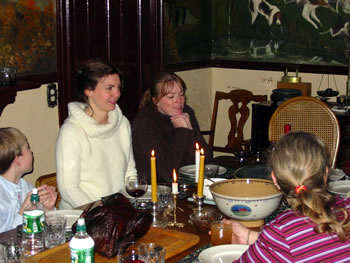Merlin Mann offers some year-end thoughts about Getting Things Done.
Looking at my Tinderbox container named Done, I find that this year I moved 758 things from my list of things to do into my list of things I got done.
Merlin Mann offers some year-end thoughts about Getting Things Done.
Looking at my Tinderbox container named Done, I find that this year I moved 758 things from my list of things to do into my list of things I got done.
Linda suggested this morning that we should follow Sweden and declare a National Day of Mourning. I worried, though, that this would be one step closer to theocracy, that we'd see a parade of fundamentalist fund-raisers on TV, accompanied by the odd rabbi or two, selected to give cover without distracting from the evangelical's message.
The answer, anyway, isn't to mourn the lost. There's work to be done. Don't mourn: get the helicopters and the doctors and the supplies where they're needed.
Bill Humphries picks his top Web development articles for 2004, including Semantic xHTML and the Tinderbox Category Factory.
I've written 434 posts so far this year. I wrote another agent to tell me.
Prototype=ProtoPost&Created>12/31/03&Created<1/1/05
109 of those posts have an image. Again, I wrote an agent to tell me.
#inside(Posts2004)&Text(.image)
In 2003, I wrote 428 posts. It's surprising that the two figures coincide so closely.
President Bush spent the day clearing brush at his Texas ranch, and riding his bicycle. The US pledged $15M to help the victims of the great earthquake of 2004. (The Bush administration raised that to $35M today, blaming Bill Clinton).
Next year, we're going to spend $87,000M in Iraq. And, in order to phase out social security and replace it with private savings accounts, the Republicans are willing to spend about $1,000,0000M.
Can someone explain our priorities?
Sorry -- too much urgent brush clearing to do!
New in the Tinderbox public file exchange, a framework for a pure-CSS information site, contributed by peace researcher Marisa Antonaya (Thailand).

But, since I already have a Tinderbox agent that collects all my book notes, it was easy enough to make a quick, temporary agent to collect all 55 notes written in 2004.
On Christmas, we go with friends to the movies. For three years, we saw Lord of the Rings. This year, we saw Sideways. It's a good little movie; don't let the reviews fool you into expecting a big movie.
This year, I've seen about 29 movies. I'll probably add two more on New Years Eve. Only three seem to have been in theaters; that surprises me.
Last year, I saw 32 movies, 6 of them in theaters. In 2002, I saw 37 -- about ten of them in theaters.
But the big question is: how many movies should I watch in a year?
On the one hand, I don't have to watch a lot of movies. I'm not a film critic, many industries affect new media at least as significantly as Hollywood. Watching film takes time.
On the other hand, there's lots of great film, and it's good to know what's going on in the world. Take Ebert's 100 Great Films: I bet I've seen fewer than half. And some of those I saw many years ago.
How many films did you see this year? How many should you want to see next year?
Response: Susan Mernit.
I'm enjoying Caress of Twilight, the second volume in Laurel Hamilton's lovely series I like to call faerie porn. It's beach reading for cold winter nights.
See also A Kiss of Shadows and War for the Oaks.
Diane Greco blogs TEKKA and TEKKAlogue , which she describes as " a curious new blog co-authored by three made-up characters. "
A gingerbread CPU, from MediaTinker very Dr. Meryl. Wow! Check out the licorice capacitors and DIPs!

Stuart Moultrop and Nancy Kaplan interview each other on the state of reading, writing, and eliteracy.
John [McDaid] used to quip that it would take three media ecologists to change a light bulb: one to remove the old and insert the new, one to study the effects, and a third to mourn the passing of the candle.
Richard Chamberlain's Sunset and Labrea is back in Tinderbox, having wandered through Textpattern, Wordpress, and Filemaker.
One thing which is astonishingly good about Tinderbox is that you have the ability to structure things exactly how you would want to structure them .... It's also a good time to mention how good support is at Eastgate Systems, who are the developers of Tinderbox. During my rebuild I had a few questions all of which got answered within twelve hours, and one within ten minutes. Considering we live in different time zones that is very impressive.
A new issue of TEKKA is out.
Lots of important stuff. Diane Greco on the theory of diet blogs. NPR music critic Ed Ward on the music industry, and why everybody is chasing the wrong thing. Stuart Moulthrop has a new New Media piece.
Lots more. We'll talk about it shortly.

A nice discussion is ongoing at 43 Folders, on whether Tinderbox merits a pricetag that's significantly higher than some "scratchpad" apps.
It's the only thing I've ever seen that lets me write one document and then generate several other documents based on it by filtering and transforming based on metadata. Once you've gotten used to it, how natural it is is scary. The little icons in the outline, for example, yellow with age. The little icons also show the basic shape of each note's contents. God it's awesome. -- Arthur A. Vanderbilt
It's worth it if your information is in any way complex; if you start with random thoughts and build towards a linear structure; if you use multiple "views" onto the same information; if you work by making connections between individual ideas. I am a professional writer & I wouldn't want to do without Tinderbox now, any more than I'd want to do without my WP. -- Michael Bywater
If you're serious about learning how to use Tinderbox, you might want to attend an upcoming Tinderbox Weekend. These are intensive training sessions over the course of a weekend that can really help both new and experienced Tinderbox users get even more out of the software.... I *always* have at least two, if not more Tinderbox documents open. This software is definitely worth not just the investment of $145 to buy it, but the time and effort you'll invest in learning how to make it really do tricks. -- Doug Miller
A correspondent wrote to suggest that testing user interfaces isn't really as hard as it's cracked up to be.
Let's take something very simple and self-contained. There's a widget on the screen -- a Tinderbox note, maybe -- and we've given it a name. We ask the widget, "What's your name?" and make sure the answer is right. What can go wrong?
A lot.
Here's my quick list of some ways the widget can know its name, and yet fail to draw draw it:
I'm pretty sure I've seen all of these at some point.
Jill Walker has opened a project page onto her new research project on distributed narrative. It's a Tinderbox-driven portal onto her blog posts, papers, lectures, and teaching on the subject.
This interesting Tinderbox application will, I expect, be an influential genre-shaper. Researchers often have diverse interests; the project page is an interesting application of ad hoc faceted classification to the personal home page.

A year ago, I was writing a blog note that protested the modern critical theorist's tendency to dismiss our recent ancestors for their ideological faults. They weren't all fools.
Weblogs unfold in time, and regular readers see the new stuff first. That's as it should be. Occasional readers arrive from links and search engines, and they see one old but relevant post first; that, too, is as it should be.
Elin Sjursen is working on some very interesting ideas about renegotiating time in weblog narrative. More on this soon.
But how can we make old writing useful -- and how can we direct attention toward evergreeen posts ? The faults of finding the male gaze under every bed won't be old news tomorrow. A better way of presenting a year ago might help.
One of the nice things about Tinderbox is that you can do something about features like A Year Ago. Your data is yours. For example, I set up my version of A Year Ago to cheat: it looks for the most substantial post that was roughly a year ago, so you're less likely to hear about last year's cheese sandwich.
Same thing with my book notes. At the top of this column, I've provided links to the most notes from my reading weblog. As an experiment, I've replaced the title links with thumbnails of the book covers. These might be more interesting to readers -- and might relieve this extremely text-heavy page. Or, people might dismiss the images as ads for selling books, and find my commentary an impediment. How would I find out which reaction is most important? (Hint: counting noses is probably the wrong methodology)
Update: thoughtful discussion more technology from Martin Spernau.
There's a microflap in the RSS world right now. It started when a blogger lost her data, and then lost her temper.
She did this very publicly, and because she has good friends and good enemies she did this very visibly. The spreading ripples have left lots of name calling in the wake. ( I'm not going to link to the flap; it's a fender bender. Nothing to see. Move on.)
Software will make mistakes. This is emphatically true of beta software, which is what this unhappy blogger was using. You should expect beta software to do bad things, but even release software will, occasionally, not behave as it should. (Even if it behaves as it should, this may not be what you expect, and in that case the fault might not lie with the software)
Software is complex. Tinderbox, for example, is not the largest or most complicated program out there -- but it's very large and very complex and has a vast number of moving parts. The operating system has lots of parts, too.
Nobody knows how to write bug-free software. In fact, nobody knows how to write software that won't crash and lose your data. Nobody knows how to cure cancer or fly to Mars or put a chicken in very pot. We're working on it. The longest journey begins with a single step.
Aaron Swartz reminds me that we do know how to make some software nearly bug-free. But this requires that the software perform tasks we understand very well, and also requires that it have almost no interface because interface tasks are almost never well understood. In other words, we can write bug-free software, but not for exciting, innovative tasks that change the world for people who don't have computer science degrees.
Use common sense. The very first words on web page of the product that aroused such ire are "Beta software has bugs! Nasty, vicious bugs with great big, sharp teeth! Don’t use beta software unless you’re clear on what 'beta' means and you’re comfortable running beta software." Later, the vendor specifically warns against testing the feature that caused the problem.
Don't listen to the pundits. Newspaper and magazine columnists write as if defect-free programs were as easy to ship as defect-free automobiles. It isn't. Get used to it. Don't listen to the pros, either, unless you know them well and know enough about the field to be sure you're a good judge. A lot of people who seem to be serious experts are really cranks.
Software pricing is out of whack. In the instance, an influential professional was using free 30-day trials to select a professional tool she used extensively every day, a tool that was close to the center of her worklife. How much would the successful vendor receive for winning the competition? $24.95 . This is absurd.
Modest Needs is a website that collects requests from people who suddenly, urgently need a little cash. People who need help with rent, or fixing a car, or whatever -- people who are stuck.
They match small gifts from individuals with small needs -- averaging $180.
Jill posts a flurry of interesting notes, and perhaps the most interesting concerns a blog-style remix of Olia Lialina's My Boyfriend Came Back from the War. Jill says
It's been remixed many times, but this is the worst example I've seen.
It's pretty bad. The whole point of this nifty little work is progressive disclosure; it's the very essence of Aarseth's ergodic. Reverse chronological order is probably the worst choice, the blog's ease of use contradicts ergodicity, and the template resists the collage that is so important to the work's effect.
I can't imagine what the implementer had in mind. I can't imagine who to blame: Olia's site attributes it to "abe linkoln", but I can't find any evidence of that. (The remix suffers from that common blog annoyance, the coyly hidden or missing link to the person responsible. I guess people imagine this is charmingly modest. They're mistaken.)
The original was important, fine, and influential. I'd like to know what became of Lialina, what her films are like, and what of her subsequent work is most worthwhile. (Attn: Gene, Ina, and Lilia -- literary hypertext could probably use a hand here from someone who reads Russian....)
We're still ovenless. Our kitchen, as Buffy would say, is dusted.
It's been that way since Vienna; that's a long time to be cooking on hot plates.
Friday night, we tried some smoked scallops with a commercially packaged (but tasty) Balinese/Indonesian sauce, made better with lots of scallions and a melange of tasty (though expensive) mushrooms. (We had a Mas Carlot syrah-grenache, which I think has some bryttomyces, or perhaps was corked)
Saturday night, I tried some store-bought (Grimaud) duck confit, crisped, with garlicky potatoes. That worked really well; I like my confit better because I can use more herbs, but this was good -- and I don't have an oven so it's the only game in town. I wasn't that eager to finish the Mas Carlot, so we opened an inexpensive Minervois.
It's surprising how much you can do with a hot plate -- and how indulgent you can get with the groceries before you come close the damage a trip to the diner will do.
In 1938, The Terminal would have ended with the stewardess marrying Viktor Navorski who would become an American citizen and be welcomed to the free world.
In 1962, The Terminal would have ended with all the airport workers conspiring against management to escort Victor Navorsky to the nightclub of his father's dreams. Or maybe they'd have moved the nightclub into Idlewild.
In 2005, there would be no movie; Victor Navorsky would have been thrown in a Federal Prison for a few years and then sent home to Krakozia, where he'd become a leader in anti-American politics.
But, for the present, it's charming.
There are 46.00 posts so far this month. They have an average length of 118.17 words. (This number will changes as I add new posts)
This is one of the interesting things you will be able to do with Tinderbox 2.4 , which adds the ability to do calculations over related notes and collect statistics or make descisions based on the note's children, descendants, siblings, or ancestors.
Because Tinderbox 2.4 isn't finished yet, I had resisted the impulse to try these features here. But, it turns out not showing off meant we didn't catch a bug that would have been caught if I'd gone ahead and enjoyed the new features right away.

February 12-13, 2005. Can't wait.
I just heard the good news that Johns Hopkins Press will be publishing George Landow's Hypertext 3.0 next year. V
We often talk about the way tools shape writing. Place shapes writing too. Here's a quiz: read the following post, and guess whether it was written in Blogger, TypePad, or LiveJournal:
...Storyspace which has got to be the bestest most super wonderful magical hypertext writing program there is in the universe and beyond. 10 years gone and I haven't found anything that compares. And haven't figured out a way to get my hands on it either.
I took The Wild Party
to lunch today. I'd forgotten how good Joseph Moncure March can be:
Scott Rosenberg has an extensive interview with Joel Spolsky in Salon. Despite the pedestrian opening, there's some good stuff here.
Eastgate celebrate's its 22nd birthday tomorrow, December 9.
Would you like to send a birthday card? Email it to happy_birthday@eastgate.com . If we can steal a moment from non-stop partying, we'll try to share birthday cards on the Web.
Eric Scheid sends an interesting paper from WWW12: On the bursty evolution of Blogspace (pdf).
We define definitions and algorithms for time-sdense community tracking, to crystallize the notion of community evolution.
Also, Anja Rau weighs in with more commentary on the evolving ecology of weblogs.
Further discussion on blog networks: Stephanie is researching the matter, and suggests that private communication is replacing blog conversations. Jon replies, echoing Diane and indulging in some clever wordplay to answer Torill.
Lilia and Stephanie 's paper (thanks Jill and Elin) is useful in establishing the existence of clusters and presenting a useful visualization (although I do wish they'd explained the embedding in 3-space they used, and that I understood the difference between figures 3 and 6) They look at a group of weblogs that link to each other at least 3 times in a span of 7 months; they start with knowledge management but discover interesting secondary clusters in cooking. Is this our old IR friend, topic drift? I bet it's not -- I bet it's a distinct phenomenon. How would we prove that?
What Efimova and Hendrick haven't (yet) done in this paper is to develop metrics that characterize the link graph; with the right metric, we'd be able to measure its change over time. (Cyclometric complexity? Mean or rms out-degree? Mean shortest path between all node pairs? Edge count?) With a metric in hand, we could measure the change over time, and then we'd have an answer. (Old papers of tangential relevance here and there).
I'd also love to see an expansion of their distinction among kinds of links; the decision to study links among posts and to exclude blogrolls and comments is, I think, very useful. Can this be expanded to semantic role without becoming arbitrary? It would be nice to be able to distinguish
A.B. Clump proposes his 23rd Conjecture (link), but fails to observe that the ocelot and the sloth are counter-examples to his hypothesis
from
A. B. Clump (link) dropped by for lunch, we had a cheese sandwich and discussed his recent paper.
Would the Nanard's old idea, "Should Link Anchors Be Typed Too?" be helpful here?
I guess some people are pretty unhappy with me. May I respectfully point out that I don't matter in this? That I'm irrelevant?
My conjecture was: patterns of linkage in this strongly-connected component of the Web have changed. And I further observed that, to the best of my knowledge, we don't know exactly how to prove or disprove this conjecture, but should be able to develop techniques for doing so.
If my hypothesis is true, that'd be interesting. If so, we'll have learned a little about the blogosphere. We can ask other questions. Is the change happening elsewhere? Is it continuous? Is it ongoing? Is it monotonic? Is it uniform?
Or perhaps the data don't confirm my conjecture. Am I unhappy to be wrong? Not in the least! Maybe, if the someone does a really great job solving the problem, I'm a little unhappy that I didn't think of the solution first. But, you know, I'm used to that; there are lots of experiments I didn't think up first.
Last year: face to face.

Today: Interesting face-to-face discussion with Elin on gender issues and my weblog cluster question.
Elin speculates that there's a gender issue underpinning this. What's wrong with social bonding?
My answer was, "In the end, the identity of the molecule, or the phenomenology of the blogosphere, don't depend on you or me, much less your body or my body. In time, we're dust -- but the facts and the phenomena will still be true."
But that's not a completely satisfactory answer, obviously. For example, see Lilia Efimova's notes on the use of time for blogging.
Perhaps we need meeting reports about face-to-face discussions, even at the risk of misstating someone else's position?
I'd still like to know: how would you measure interchange of ideas across a cluster of weblogs. That's an interesting question, I think, even if my query is simply wrong.
More: Jill extends her response. Jon Buscall responds, too. Diane observes crucially that writing in comments in different in important ways.
...what no one has yet mentioned is how the writing changes depending on whether one is writing a comment or a post in one's own blog. And here's where I want to throw my hat into our ring. When I comment on a blog post, the context is made for me. I don't have to situate the author or her comments, as I have done, albeit sketchily, for Mark and Jill in this post. I don't have to engage with the ideas by filtering them through my own sensibility. I can just respond; I don't have to write, meaning I don't have to engage with other voices, other writers, other ideas while also presenting my own.
Still more: Derik Badman on clusters in book blogs.
Another methodological problem in search of a researcher.
Last night, a friend asked me how many people read this blog. "About a thousand, I guess." It's hard to know exactly in this era of bots of newsreaders and proxy servers.
I thought I'd take a look. It seems I'm wrong by at least an order of magnitude. 15,200 unique hosts last month.
Lesson 1: Watch your server logs occasionally.
Lesson 2: The RSS syndication file gets hit 100,000 times a month.
Lesson 3: Things change, even when nothing seems to be happening.
Lesson 4: Some of those unique hosts are bots. Some real readers are hidden behind proxies -- AOL, universities, all sorts of people. I bet there's a good way to estimate actual readership from unique hosts; anyone got a method?
I think we need a capable student to take a closer look at weblog clusters and the way they change over time.
For example, consider what I call the Scandinavian-flavored Hypertext Weblog Cluster. It used to be one of the best places in the world to read about new developments in new media, and it used to be one of the best illustrations of a hypertextually-interlinked cluster.
Perhaps its just one of those thing -- perhaps it's a complete illusion -- but it's my impression that the weblogs of this cluster have largely stopped responding to each other's ideas. I see fewer links amongst them, I think, and those links I notice tend to be social -- about relationships among people rather than between ideas.
Change is inevitable, of course. Two years ago, a bunch of the professors in this cluster were students. A bunch of them have moved. People have babies. Kids grow up. People fall into and out of love. You expect change.
But when was the last time Jill reviewed a hypertext, and Torill wrote a day later that she'd missed a vital point? How long has it been since Adrian proposed a new theory, Lis probed it, Anders elaborated it, and Elin puzzled over it? When did Anja last tell us how we were wrong, to be rebutted by Noah, refined by Diane, and replayed by Gonzalo?
I don't know if this is a phenomenon or an illusion. The answer is knowable; I think someone should find out. (A rough-and-ready approach will be fine, but I think one could write a nifty little paper for HT05 and maybe CHI describing a rigorous and nuanced methodology for answering questions like this)
If the conjecture proves valid, we should look for an explanation. My prime suspect: do comments reduce writers' desire to link? But perhaps we should confirm that a crime has been committed before we start the lineup.
Update: Jill responds, arguing that I'm indulging in nostalgia for an imaginary past and misled by shifting and growing disciplinary boundaries. She may well be right. I would like to know whether Jill is right. This is the kind of question that should yield easily to rigorous scholarship, and showing us how to answer the question would demonstrate the value of weblog scholarship. (I also think it's weird that professors have less time for research than they did as graduate students, but that's a question for another day.)
Update 2: Torill responds as well, reiterating Jill's point and also suggesting that, as these scholars have achieved greater prominence, they no longer need to publish. "We are in positions where we don't have to talk through the blogs. We can invite each others for lectures and speeches, and then we can do the commenting face to face." As a scientist, I find this strange and dismaying: the first duty of a scientist is to disseminate the data. But the humanities are not like you and I.
Update 3: Anders responds, too, also commenting on Jill and Torill. Jill has already replied to Anders in a comment.
So, the cluster's still here and the machinery still works -- at least, if you give it a good kick.
The NY Times publishes its annual list of Notable Books.
The pairing of the Times list on one screen and the amazon and alibris catalogs on another is a singularly effective way to update your reading list. I grabbed a book on 1912 and another on drawing; I hadn't yet heard or seen either book.
Liz Dubelman has created some nicely-produced digital stories at VidLit. The sound track is unusually well done. Thanks, k10k.
I'm totally in love with Tinderbox. It rules my life in a really, really good way. Class notes make more sense, my personal life is marginally more organized.... papers are a lot easier to write. -- Brian McGuirk, Brown University
Hypertext author Nick Tyler has a new film review page. Now, we need RSS and an aggregator for intelligent film notes.

The next Tinderbox Weekend will be in Boston, February 12-13, 2005. You can save by registering early.
Elin Sjursen will be back with her broad introduction to Tinderbox -- the lecture that elicited oohs and ahs from experienced Tinderbloggers in San Francisco. I'll demonstrate HTML export -- building an elaborate, full-featured CSS site from scratch. We'll have lots of new features and applications, too -- including a look at some exciting new features in Tinderbox 2.4 .
We hope to have more space this year than we did for the first Tinderbox weekend, but it would be a good idea to reserve your seat right away.